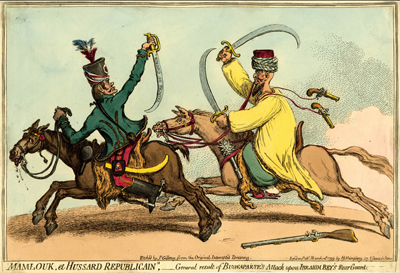Mamlouk, et Hussard Republicain. . .
This is one of six prints from the series, Egyptian Sketches, created by Gillray in response to the French invasion of Egypt by Napoleon. For more information about the series as a whole, see my commentary on the title page, Egyptian Sketches.
The complete title is Mamlouk, et Hussard Republicain,—General Result of Buonaparte's Attack upon Ibrahim Bey's Rear Guard.

[March 12, 1799]
© Trustees of the British Museum
The Mamelukes* were a warrior caste under the leadership of Murad and Ibrahim Bey, the de facto rulers of Egypt. As such they were the principal obstacles Napoleon had to face in his attempt to conquer Egypt. Famously skilled as warriors and horsemen, the Mamelukes were a fearsome foe in one-on-one combat. But in pitched battles they were no match for the more numerous, better equipped, and highly trained and disciplined Republican army under Napoleon. After the disastrous Battle of the Pyramids (July 21, 1798), Murad Bey retreated to upper Egypt and Ibrahim Bey to Belbeis. Both were pursued by the French, but managed to stay one step ahead of Napoleon's forces, avoiding major combat and inflicting damage in small skirmishes. After Nelson's victory at the Battle of the Nile when the French were cut off from the sources of their supplies, the Turks were then able to fight a war of attrition.
In this sketch, a Mameluke warrior armed with pistols, scimitars, and a mace, is pursuing a Republican Hussard who carries a sword with a French inscription which can be roughly translated as "fight or flee." And in this case there is no doubt who is fighting and who is fleeing. Following the track of the fallen gun and galloping horses, everything moves from right to left.
Like most of the other "sketches" in the series, the figures are greatly simplified and set against a mostly blank background. And in keeping with the prevailing emphasis upon the absurdities of the French mission, the print is more comic than most Gillray prints, employing the well-worn comic technique of having the emotions of the human figures in the print duplicated and/or exaggerated by the animals.
* "Mameluke" is spelled in a variety of ways both by Gillray and by historians, e.g. Mamaluke. Mameluke, Mamlouk, and Mamluk. In the text of my commentary, I will use Mameluke except where I am quoting from a source that spells it otherwise.
Sources and Reading
- Commentary from the British Museum on Mamlouk, et Hussard Republicain.
- "Mamluk," Wikipedia
- "Ibrahim Bey (Mamluk)," Wikipedia
- "Hussard," Wikipedia
- "French campaign in Egypt and Syria," Wikipedia
- The Napoleonic Invasion of Egypt
- Thomas Wright and R.H. Evans, Historical and Descriptive Account of the Caricatures of James Gillray #226
- Thomas Wright and Joseph Grego, The Works of James Gillray, the Caricaturist; With the History of His Life and Times p. 257.
Comments & Corrections
NOTE: Comments and/or corrections are always appreciated. To make that easier, I have included a form below that you can use. I promise never to share any of the info provided without your express permission.